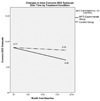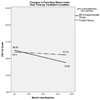A Collaboratively Designed Child Mental Health Service Model: Multiple Family Groups for Urban Children with Conduct Difficulties
- PMID: 22194642
- PMCID: PMC3243310
- DOI: 10.1177/1049731511406740
A Collaboratively Designed Child Mental Health Service Model: Multiple Family Groups for Urban Children with Conduct Difficulties
Abstract
This paper presents preliminary outcomes associated with an experimental, longitudinal study of a Multiple Family Group (MFG) service delivery approach set within thirteen urban outpatient clinics serving children and their families living in inner-city, primarily African American and Latino communities. Specifically, this paper focuses on parent reports of child oppositional behavior and parenting stress over time. MFG is a flexible, protocol-driven approach designed to address the most common reason for referral to outpatient child mental health clinics, childhood behavioral difficulties. The MFG also aims to enhance family-level engagement and retention in ongoing care. Further, the service delivery model was collaboratively developed with intensive input from parents rearing children with conduct difficulties, parent advocates, community-based child mental health providers and services research staff in order to ultimately expand the number of effective service models that can be situated within "real world," urban child mental health settings.
Figures
References
-
- Alexander JF, Robbins MS, Sexton TL. Family-based interventions with older, at-risk youth: From promise to proof to practice. Journal of Primary Prevention. 2000;21:185–206.
-
- Anderson CM, Griffin S, Rossi A, Pagonis I, et al. A comparative study of the impact of education vs. process groups for families of patients with affective disorders. Family Process. 1986;25:185–205. - PubMed
-
- Angold A, Costello EJ. The epidemiology of disorders of conduct: Nosological issues and comorbidity. In: Hill J, Maughan B, editors. Conduct disorders in childhood and adolescence. New York: Cambridge University Press; 2001. pp. 126–168.
-
- Aponte HJ, Zarski J, Bixenstene C, Cibik P. Home/community based services: A two-tier approach. American Journal of Orthopsychiatry. 1991;61:403–408. - PubMed
-
- Attar BK, Guerra NG, Tolan PH. Neighborhood disadvantage, stressful life events, and adjustment in urban elementary-school children. Journal of Clinical Child Psychology. 1994;23:391–400.
Grants and funding
LinkOut - more resources
Full Text Sources



